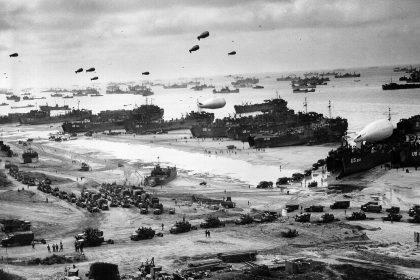The Berlin Blockade and Airlift (1948–1949), one of the first major crises of the Cold War, set the stage for the long geopolitical struggle between the United States and the Soviet Union. This pivotal event reinforced the division of Europe and demonstrated the Western Allies’ determination and ability to counter Soviet expansionism.
Post-War Europe and Escalating Tensions
The United States, the Soviet Union, the United Kingdom, and France divided Germany into four occupation zones at the end of World War II. Berlin, situated deep within the Soviet zone, also saw its division into four sectors. Despite wartime cooperation between the Allied powers, deep ideological differences soon emerged and competing visions for post-war Europe emerged.
The ideological clash between capitalism and communism, along with mutual suspicions, fueled the emerging Cold War. While the United States sought to rebuild Europe along democratic and capitalist lines through initiatives such as the Marshall Plan, the Soviet Union sought to expand its influence by establishing communist regimes in Eastern Europe. Berlin became a theater of conflict and the symbolic heart of a divided Germany.
The Berlin Blockade: Soviet Strategy and Western Response
Stalin’s Blockade
In June 1948, Soviet Premier Joseph Stalin launched the Berlin Blockade, cutting off all land and water routes between West Berlin and West Germany. With this blockade, Stalin aimed to force the Western Allies to withdraw from Berlin or negotiate on Soviet terms, which would give the Soviet Union control of the city.
The Western Allies’ Dilemma
Faced with the blockade, the Western Allies’ options were limited. Direct military intervention risked triggering a new war, while withdrawal from Berlin would weaken their position in Europe and give the Soviets a major propaganda victory. Instead, the Allies developed a bold plan to airlift the city.
Berlin Airlift: A Logistical Victory
Operation Vittles
The Berlin Airlift, called “Operation Vittles” by the Americans and “Operation Plainfare” by the British, began in June 1948. It aimed to provide food, fuel, and other essentials to two million West Berliners entirely by air. This unique logistical operation required meticulous planning and coordination.
For the next 15 months, Allied cargo planes worked around the clock, moving up to 8,000 tons of supplies daily. The operation faced many challenges, including bad weather, mechanical breakdowns, and the constant threat of Soviet intervention. But the airlift’s success demonstrated Allied determination and ingenuity.
Impact: Political and Humanitarian Consequences
Symbol of Stability
The Berlin Airlift became a powerful symbol of the Western Allies’ determination to counter Soviet aggression without direct military confrontation. It sent the message that the Allies would not abandon Berlin, and therefore would not abandon their commitment to prevent communism in Europe.
The airlift also revealed the human dimension of the Cold War. The constant effort to feed and support the people of Berlin placed West Berlin at the forefront of the ideological battle and won many hearts.
The End of the Blockade and Aftermath
Lifting the Blockade
Realizing the futility of the blockade and the propaganda defeat it represented, Stalin lifted it on May 12, 1949. The Western Allies continued air resupply until September to ensure that West Berlin had sufficient stocks.
The Creation of NATO and the Formation of the German States
The Berlin Blockade and Airlift accelerated the division of Germany into two states: The Federal Republic of Germany (West Germany) and the German Democratic Republic (East Germany). It also triggered the creation of the North Atlantic Treaty Organization (NATO), a military alliance against Soviet expansionism.
Conclusion
The Berlin Blockade and Airlift were two of the events that ignited the Cold War, setting the stage for a long struggle between the superpowers. The crisis demonstrated the ideological divide in Europe and the determination of the Western Allies to defend democracy and freedom. Beyond providing a lifeline to the people of Berlin, the airlift emphasized the importance of unity and resilience and proved that victory was possible in the face of adversity.






